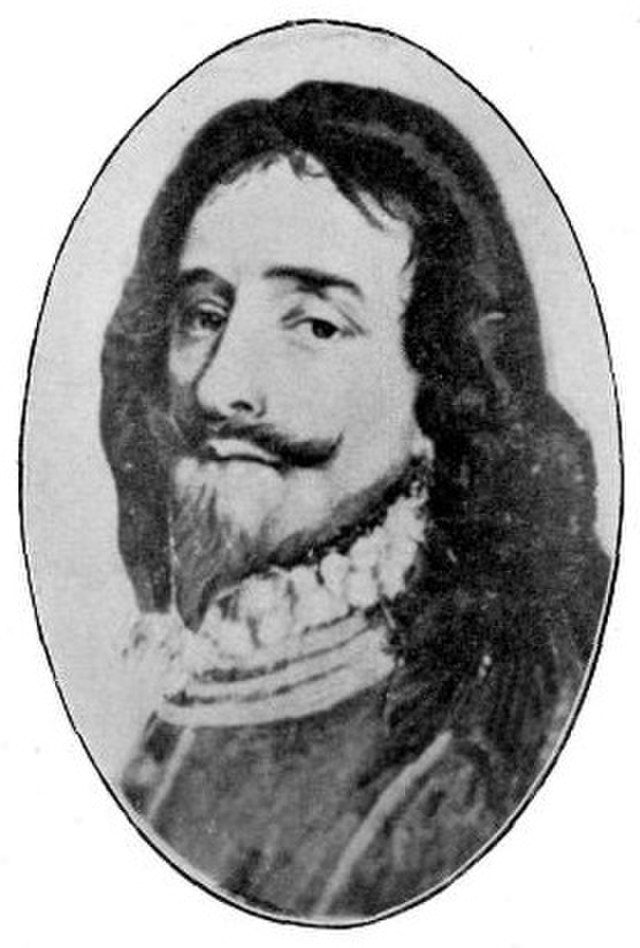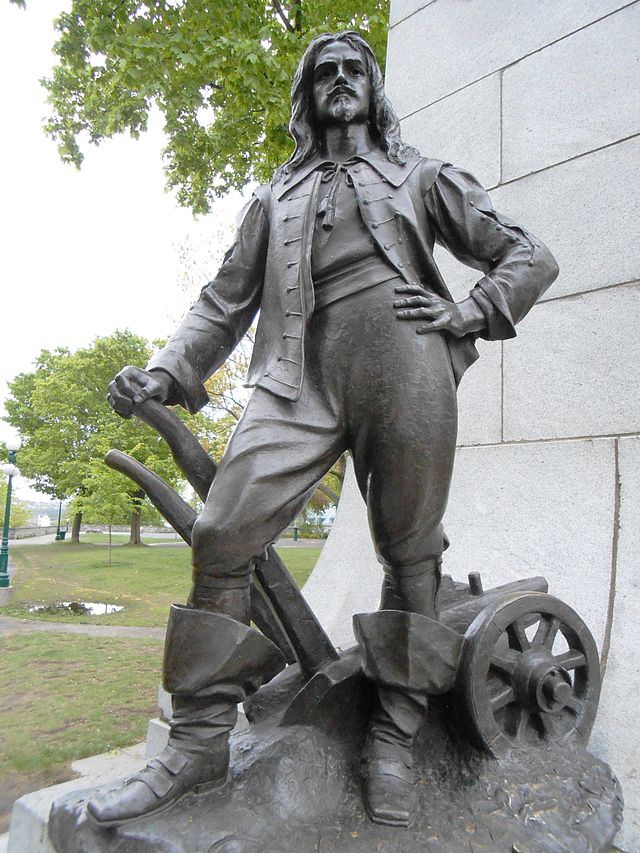Guillaume Couillard de L’Espinay was one of the first to settle permanently in New France. According to Samuel de Champlain, he arrived in New France in 1613. Couillard is my tenth great-grandfather on my mother’s side and the earliest of my ancestors to settle in New France. Join me as I explore Guillaume Cuillard’s life and the role he played in New France’s early history:
Biological Family and Siblings
Guillaume Cuillard was born on October 11, 1588 in Saint-Servan, Ille-et-Vilaine, Brittany, France. It’s unclear who his real parents are. Some sources point to André Couillard and Jehanne Basset while others suggest that Guillaume Couillard and Élisabeth de Vesins are his parents. Records show that he had five siblings who were all born between 1586 and 1600.
Settling in New France
According to Samuel de Champlain, Couillard came to New France in 1613, just five years after the colony was first established with just 28 men. Couillard was 25 years old. He was working as a carpenter, sailor and caulker for the Company of One Hundred Associates, which at the time was called the Compagnie de Montmorency. The population in New France was quite small at the time. By 1620, only 60 people were living in the French colony.

Guillaume Couillard’s Marriage
On August 26, 1621, Guillaume Couillard married Marie-Guillemette Hébert, Louis Hébert and Marie Rollet’s daughter, at Notre-Dame de Quebec Church. Samuel de Champlain and his brother-in-law Eustache Boullé were in attendance. Couillard and Guillemette had ten children together: Louise, Marguerite, Louis, Élisabeth, Marie, Guillaume, Madeleine, Nicolas, Charles and Catherine Gertrude.
After Louis Hébert’s death in 1627, Couillard and Guillemette inherited half of his estate. Couillard took over farming Hébert’s land. That same year, Champlain granted him a hundred acres of land to clear and seed along the St. Charles River. By 1632, he had nearly 20 acres under cultivation.
British Occupation of New France
In 1628, British privateers led by David, Louis and Thomas Kirke arrived at the mouth of the St. Lawrence River and began pillaging and burning French farmsteads. They demanded that Samuel de Champlain surrender Quebec, but he refused. Champlain ordered Guillaume Couillard to go to Tadoussac to repair and bring back a boat to move unessential people toward the Gaspé; however, Couillard refused. He did not want to leave his wife. In 1629, Champlain was forced to surrender Quebec to the British. Couillard and Guillemette Hébert stayed in New France during the occupation, which lasted until 1632.
Guillaume Couillard’s Important Role in New France
Guillaume Couillard played a vital role in New France. He helped defend the colony from the Haudenosaunee (the Iroquois) and frequently piloted boats between Quebec and Tadoussac. He also became the churchwarden of the parish after he offered some of his lands for the reconstruction of the church. In 1654, Governor Jean de Lauson’s administration knighted Couillard for the services he had rendered to the colony; however, the title was later revoked.
Couillard died on March 4, 1663. The following day, he was buried in the chapel of the Hôtel-Dieu. After his death, Guillemette Hébert sold his house and a good portion of his land to Bishop Laval to establish the Seminary of Quebec. A cairn inside a courtyard in the seminary marks the location of the house. There’s also a statue of Couillard beside the city hall of Quebec City.

My Connection to Guillaume Couillard
I am related to Guillaume Couillard in two ways, both through my mother.
Connection One
- Guillaume Couillard de L’Espinay (1588 – 1663) and Marie Guillemette Hébert (abt. 1608 – 1684)
- Élisabeth Couillard (1631 – 1704) and Jean Guyon (1619 – 1694)
- Catherine Gertrude Guyon (1660 – 1715) and Denis Belleperche (1651 – 1710)
- Pierre Belleperche (1699 – 1767) and Marie Anne Campeau (1712 – 1796)
- Francoise Belleperche (1740 – 1796) and Joseph Gabriel Pouget (1728 – 1801)
- Susanne Pouget (1776 – 1821) and Pierre Baron (1767 – 1835)
- Hyacinthe Baron (1806 – abt. 1881) and Marie Josephte ‘Josette’ Joannes dit Debaucamp (1812 – 1881)
- Marguerite Baron (1832 – 1898) and Eli Bondy (1827 – 1894)
- Joseph Edward Eli Bondy (1858 – 1944) and Amelia Isabella Brush (1864 – 1935)
- Pearl Leafy Bondy (1885 – 1966) and Edward Walter Grondin (1886 – 1973)
- Walter Grondin (1910 – 1998) and Mary Catherine Higgins (1908 – 1983)
- Martha Grondin (Born 1950) and Gary Willis (Born 1946) – my parents
Connection Two
- Guillaume Couillard de L’Espinay (1588 – 1663) and Marie Guillemette Hébert (abt. 1608 – 1684)
- Élisabeth Couillard (1631 – 1704) and Jean Guyon (1619 – 1694)
- Catherine Gertrude Guyon (1660 – 1715) and Denis Belleperche (1651 – 1710)
- Pierre Belleperche (1699 – 1767) and Marie Anne Campeau (1712 – 1796)
- Francoise Belleperche (1740 – 1796) and Joseph Gabriel Pouget (1728 – 1801)
- Charles Pouget (1764 – 1776) and Marie Anne Pageot (1776 – 1864)
- Florence Pouget (1804 – 1857) and Etienne Meloche (1799 – 1839)
- Olive Meloche (1828 – 1916) and Patrice Barron (1822 – 1898)
- Catherine Barron (1854 – 1939) and Antoine Solomon Renaud (1853 – 1926)
- Mary Zoé Renaud (1878 – 1935) and Abraham Joseph Higgins (1875 – 1950)
- Mary Catherine Higgins (1908 – 1983) and Walter Grondin (1910 – 1998)
- Martha Grondin (born 1950) and Gary Willis (born 1946) – my parents
Guillaume Couillard’s Descendants
Guillaume Couillard and Guillemette Hébert had 10 children. Since these children have numerous descendants, Couillard appears in the genealogy of almost all the old French-Canadian families. Some of his most famous descendants are Hillary Clinton, Camilla Parker-Bowles and Celine Dion.
Are you related to Guillaume Couillard? Let me know!
Do you want to know more about the earliest settlers of New France? Check out New France’s Founding Families and Their Fascinating Stories.
Be First to Comment